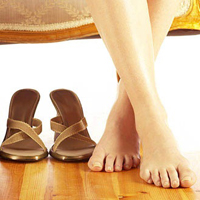 Corns - it growths on the skin that are the result of high pressure or friction. Corns on the feet are a common problem among athletes as well as people who wear uncomfortable shoes or who have disorders that contribute to an uneven distribution of the load on the foot when walking. High levels of physical activity, foot deformity and more serious disorders, such as peripheral neuropathy, may contribute to the formation of corns on the feet. Corns - it growths on the skin that are the result of high pressure or friction. Corns on the feet are a common problem among athletes as well as people who wear uncomfortable shoes or who have disorders that contribute to an uneven distribution of the load on the foot when walking. High levels of physical activity, foot deformity and more serious disorders, such as peripheral neuropathy, may contribute to the formation of corns on the feet.
In appearance corns are areas of rough skin, the color of which is different from the color of healthy skin - usually corns have a yellowish tint. They are formed on the balls or heels - that is, those parts of the foot are exposed when walking to the strongest pressure. In addition, corns often occur on the fingers of the feet - both on their upper and on the lower side as well as between the toes. Shoes with narrow toes and high heels are often the cause of corns; these types of shoes cause a strong pressure on the toes and on the ball of the feet, resulting in a thickening of the stratum corneum.
Horny layer called the outer layer of the epidermis; one of his most important tasks is to ensure protection against mechanical damage. Any impact on the stratum corneum, which can weaken this protection leads to accelerated synthesis of the horny layer. If such exposure becomes chronic, and the body can not (normally simply no time to) restore damaged skin, begin processes such as hyperplasia (rapid increase in the number of cells) or inflammation. In the formation of corns on the feet inflammation usually not observed. However, pressure that falls on some areas of the skin, leading to the formation of solid tumors, where the stratum corneum is thicker than it should be OK; These seals Lots of walking can put pressure on the papillary dermis, causing discomfort, and mild or moderately severe pain.

Prevalence
- Age. Corns on the feet are most common in elderly patients, although they are very common among people of other age groups. This is probably due to the fact that older people often develop the disease, contributing to the formation of corns. According to rough estimates, corns on the feet are in 65% of people over sixty years.
- Ethnicity. Studies conducted in a number of Western countries have shown that people of African descent corns
Corns: Causes and Treatment
 formed more often than representatives of European ethnic groups (70% and 58%, respectively). formed more often than representatives of European ethnic groups (70% and 58%, respectively).
- Paul. Corns on the feet slightly more common in women than men, and because they are often narrow, tight shoes and high heels.

Diagnostics
Most of the patients with the appearance of corns do not go to the doctor, and provide treatment in the home. This is justified, since corns are not a serious hazard to health, and with them it is possible to cope on their own. However, if a patient is suspected that growths on the soles of corns are not, or has previously been diagnosed with diabetes should consult a doctor. Usually, the diagnosis is relatively simple examination, but sometimes doctors also conduct tests to rule out certain skin diseases.

Treatment
To treat corns in the first place to start is recommended to wear comfortable, suitable for your shoe size. Avoid too tight shoes and shoes with very thin soles; high-heeled shoes should not be worn at all times - it is better to wear them only on special occasions and in everyday life confined to a heel no higher than five or six centimeters. If necessary, you can buy special insoles that will protect certain areas of the foot from excessively strong pressure.
In addition, you must take good care of the skin of the feet - regularly remove dead skin cells and moisturize the skin. Several times a week to do a hot bath and use fatty creams for the feet. You can also apply various preparations with salicylic acid, designed to remove corns. Salicylic acid softens quickly sealed portions of the stratum corneum, but it must be used very carefully - it can cause severe irritation of the healthy skin.
The fastest way to remove corns
How to remove corns on his feet: caution
 laser - a procedure carried out in many clinics. However, such treatment will cost quite expensive; In addition, the likelihood of re-formation of corns is very high, so many patients find it more appropriate to use a less expensive means to remove corns. laser - a procedure carried out in many clinics. However, such treatment will cost quite expensive; In addition, the likelihood of re-formation of corns is very high, so many patients find it more appropriate to use a less expensive means to remove corns.
Related Articles
 Corns on her heels: where are and what to do
 How to remove corns on his feet: caution
 Traditional recipes for removing corns: how to restore the beauty of the legs
 How to treat corns: all the ways to get rid of the trouble
- Corns on her heels: where are and what to do
-
|
|
- High heart pressure causes and treatment
-
|
|